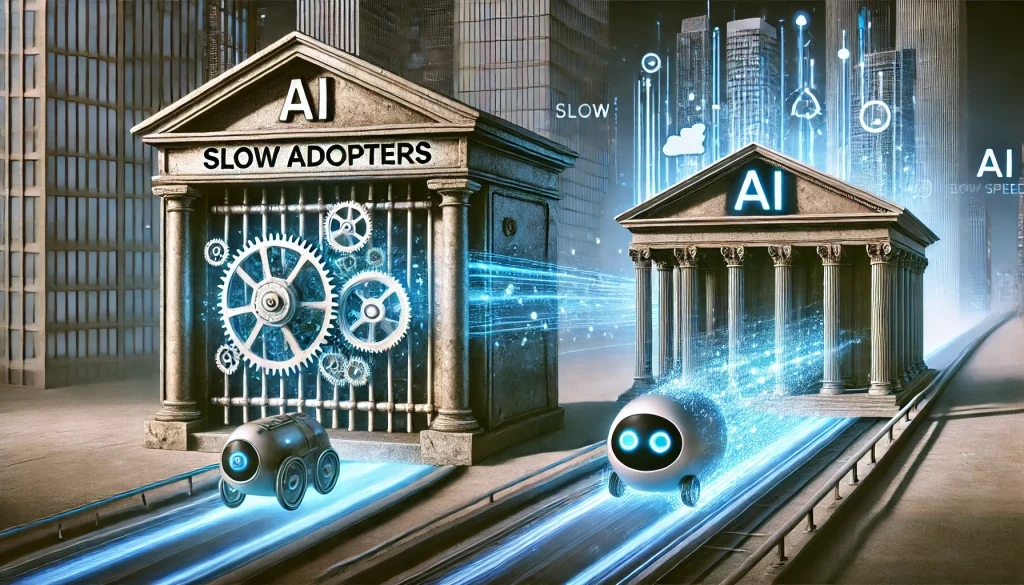The Lending Industry’s AI Dilemma: Risk, Reward, and the Future of Competitive Profitability
February 14, 2025
For decades, lending institutions have relied on software to streamline operations, enforce compliance, and reduce costs. These systems—though expensive—offer stability and reliability, allowing lenders to make confident, risk-mitigated decisions. However, artificial intelligence (AI) is poised to change this landscape.

AI is already demonstrating its ability to handle complex calculations with near-perfect accuracy and is steadily improving its ability to make judgment-based decisions once thought to be the exclusive domain of human expertise. If AI continues its trajectory, lenders who fail to integrate it into their operations today may find themselves unable to profitably compete in the future.
Sam Altman, CEO of OpenAI, has predicted that the cost of AI-driven services will decline tenfold every 12-18 months. This means that by the time the most risk-averse companies finally accept AI as the industry standard, their competitors will already be operating at significantly lower costs with vastly improved efficiency.
The question facing lending CIOs and COOs is no longer if AI will dominate, but rather when and how to implement it strategically.
The Trade-Off: Reliability vs. Competitive Agility
For IMBs, credit unions, and banks, AI adoption presents a clear risk-reward spectrum. On one end are traditional software systems—expensive, highly controlled, and predictable. Caveat this by the fact that lenders using these traditional systems are still generating loans with an average defect rate of 1.5%. On the other end are AI-powered systems—rapidly evolving, cost-effective, and potentially transformative, but still carrying an element of uncertainty.
Lenders must decide: Where do they position themselves on this spectrum?
- Traditional Non-AI Software: Provides consistency, stability, and regulatory certainty but requires high upfront costs and manual interventions for nuanced decisions. These systems struggle to adapt in real-time to changing borrower conditions, regulatory shifts, and market trends.
- AI-Driven Lending Solutions: Offer automation, efficiency, and adaptability at a fraction of the cost. AI-powered tools can assess borrower risk, validate documents, and even recommend underwriting decisions. However, these systems require careful oversight as they evolve, and early adopters must be prepared for growing pains.
The optimal approach for any lender is rarely binary. Instead, a calculated balance must be struck between maintaining reliability and embracing AI’s cost-saving and decision-enhancing capabilities. But ask yourself, do you expect the next 6-18 months to be static business conditions or rapidly changing? And, if like us your answer is “rapid changing”, how can you possibly stay current with your traditional tech stack?
The Cost of Playing It Safe: Risk Aversion in a Stagnant but Evolving Market
Today’s lending environment is stagnant, with little upward or downward movement in loan volume. Mortgage rates remain relatively high, refinancing activity is minimal, and origination costs continue to climb. At the same time, the competitive landscape is evolving as large wholesale lenders make it difficult for lenders to compete solely on rates. For risk-averse lenders who stick exclusively to traditional systems, this creates three fundamental problems:
- Diminishing Margins: Non-AI software demands significant IT investment, ongoing manual labor, and inefficient processing—eroding profitability in an already thin-margin business.
- Declining Operational Speed: AI-enabled competitors are automating document validation, loan pricing, and compliance, allowing them to process loans faster while reducing overhead costs.
- Increased Customer Attrition: Borrowers increasingly expect digital-first experiences. AI-powered solutions that deliver instant approvals and personalized interactions will quickly pull market share away from slow-moving lenders.

Companies that refuse to integrate AI into their operations may not collapse immediately, but they will be slowly outcompeted as their cost-per-loan remains high while AI-driven competitors improve efficiency year over year.
The Future of AI in Lending: Preparing for Market Volatility
While the current lending market is stagnant, history tells us that dramatic shifts are inevitable. If interest rates suddenly decline, the mortgage industry will experience a surge in refinancing activity. How will different types of lenders respond?
- Low-Risk (Traditional Software-Only) Lenders: These firms will be overwhelmed by volume. Their reliance on manual processing will cause bottlenecks, leading to delayed loan approvals, frustrated borrowers, and lost revenue.
- Medium-Risk (Hybrid AI Adoption) Lenders: These lenders will have some automation in place but may still rely on manual reviews for key decisions. They will perform moderately well, processing more loans than their low-risk counterparts but still facing some efficiency limits.
- High-Risk (AI-First) Lenders: By leveraging AI-driven underwriting, compliance automation, and instant customer interactions, these firms will handle the refinance wave at maximum efficiency, increasing their profit margins exponentially while competitors struggle to keep up.
The reality is risk-taking in AI today becomes a risk-mitigation strategy for tomorrow. Lenders who integrate AI now will own the future market share when rapid industry changes occur.
The Urgency to Act: AI Costs Are Plummeting

The lending industry has historically moved cautiously when adopting new technology, but AI isn’t following traditional technology adoption curves.
Altman’s prediction of AI cost reductions by 10x every 12-18 months means that waiting to invest in AI will not make it cheaper later—it will make competitors exponentially stronger. A lender that implements AI today at a moderate risk level will build expertise, refine processes, and scale operations efficiently by the time competitors begin catching up.
Lenders who hesitate risk permanent competitive disadvantage. Those who start small now—integrating AI into compliance, document processing, or underwriting—will secure long-term profitability and industry leadership.
Longer-term, we will likely see new entrants into the core loan origination system market that are developed “AI first.” The question as to whether lenders should wait for these solutions to arrive or start leveraging available AI sooner seems obvious to us. By traditional methods, building an end-to-end LOS that can handle conventional, FHA, VA, USDA, and non-QM loans for just one channel (e.g. retail) takes 3-4 years with a staff that has previous experience building an LOS. Even with AI-first, the number of integrations and permutations is enormous. As a result, we do not envision such a system to arrive until 2026 at the earliest. Curious whether our readers would be willing to adopt such a system if it was available today?
Conclusion: The Path Forward
Lenders must ask themselves: Will we lead in AI, or will we follow too late?
While AI still presents uncertainties, the long-term cost of inaction is far greater than the temporary growing pains of adoption. Forward-thinking lenders are already implementing AI-driven solutions for compliance, underwriting, and loan origination—gaining efficiency, reducing costs, and preparing for market shifts.
The next 12-18 months will define the winners and losers in mortgage lending. CIOs and COOs who start today will be the ones shaping the future of profitable, competitive lending.


